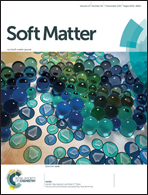Amino acid/crown ether hybrid materials: how charge affects liquid crystalline self-assembly†
Abstract
To probe the influence of electrostatic interactions on the mesomorphic self-assembly and phase behaviour of hybrid liquid crystals a series of crown ether/tyrosine hybrid systems was prepared by Steglich esterification of alkyl N-(tert-butoxycarbonyl)-L-tyrosinates with 4-carboxybenzo[15]crown-5 and 4-carboxybenzo[18]crown-6. The obtained derivatives allowed further manipulations at the NH functional group and complexation of the crown ether unit with NaI to give neutral or charged hybrid materials. All compounds were investigated by differential scanning calorimetry (DSC), polarizing optical microscopy (POM) and X-ray diffraction (XRD) measurements. Neither the variation of the N-protecting group, introduction of charge at the N-terminus nor anion exchange (Cl vs. I) resulted in mesomorphism. In contrast, N-Boc-protected and unprotected hybrids formed rectangular columnar (Colr) mesophases with phase widths up to 35 K. NaI complexation switched these neutral thermotropic derivatives into ionic liquid crystals (ILCs) and induced a change of mesophase type from Colr to smectic A (SmA). A comparison of experimentally obtained layer distances and theoretically calculated molecular lengths indicated bilayer SmA formation with interdigitated alkyl chains. Packing models for both mesophase types are proposed and discussed with respect to stabilizing interactions.



 Please wait while we load your content...
Please wait while we load your content...